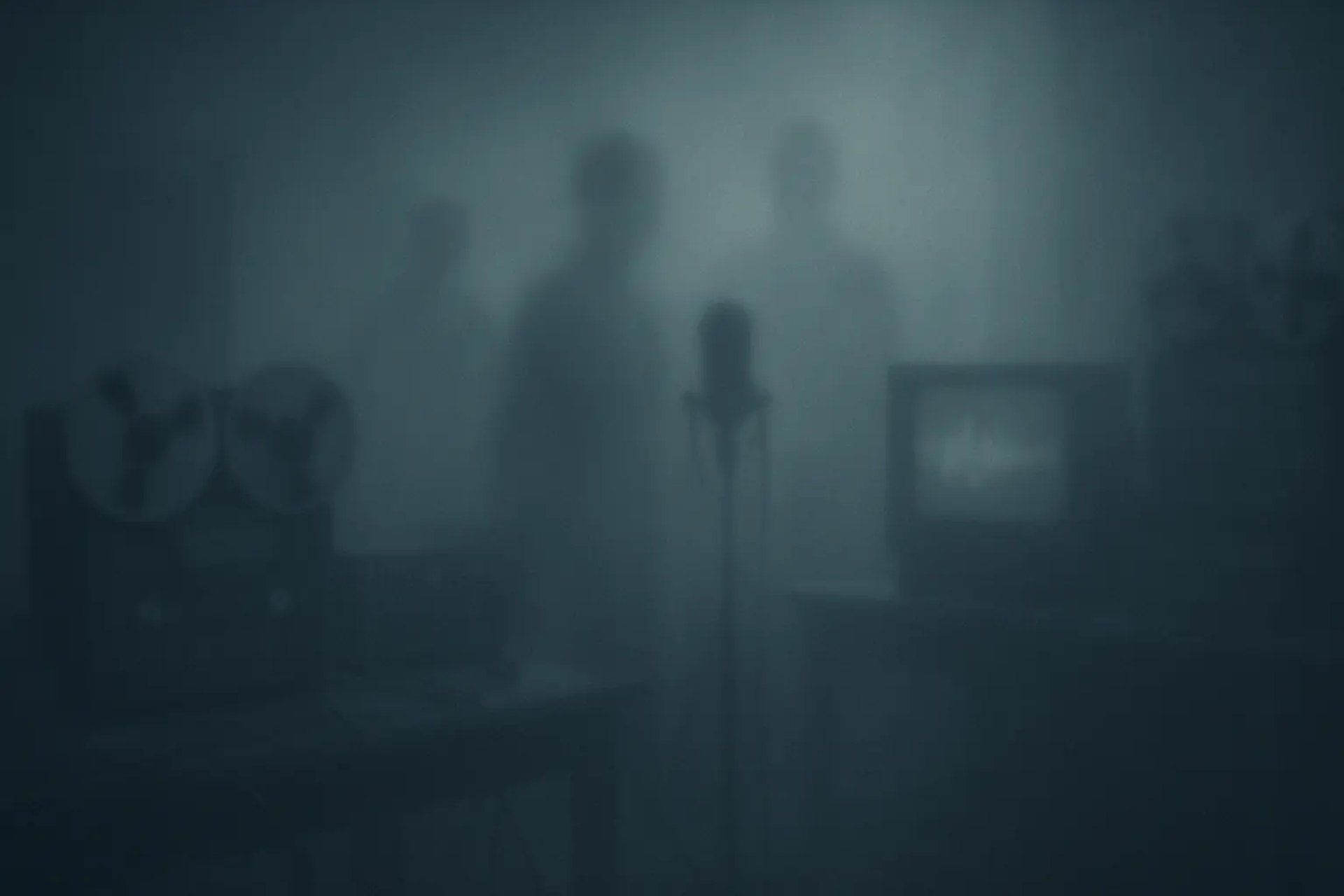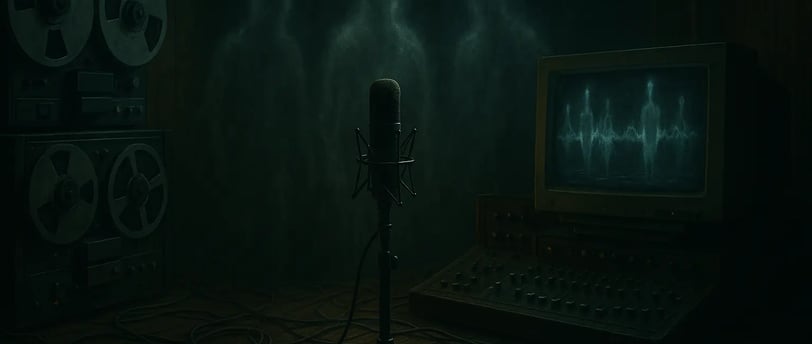AI Recreates Voices of the Dead: Haunted Echoes in the Age of Memory Technology
AI recreates voices of the dead. Explore haunted echoes and memory technology as artificial intelligence revives lost voices, blurring the line between the living and the unknown.
PARANORMAL PHENOMENA & UNEXPLAINED EVENTS
Billys Zafeiridis
7/18/20257 min read



The hiss of static is the last thing most expect to hear from a digital device. Yet somewhere, in the half-light between silence and memory, a voice rises—a voice long gone, yet unmistakably real.
AI recreates voices of the dead. The phrase alone sounds like science fiction. But as memory technology advances, the boundary between living and lost is blurring in ways that are as unsettling as they are captivating.
Some call it a comfort. Others, a heresy. For all, it is haunted.
1. Ghosts in the Machine: The Day AI Spoke the Past
It began quietly, as all modern hauntings do—not with a clattering in the attic, but with a press release.
A start-up announced their breakthrough: using artificial intelligence, they could synthesize the voice of anyone, living or dead, from a handful of old recordings. A digital séance, streamed through speakers.
Within days, the stories started circulating.
A woman weeping softly as she heard her grandmother’s lullaby, not from a dusty tape, but in a real-time conversation.
A grieving father, answering the phone to hear his son’s laughter—words he’d never recorded, jokes they’d never shared.
Some said it was a miracle. Others recoiled.
Some swore the voices weren’t quite right—there was something too crisp, too cold, as if the words were being spoken through the other side of a frosted window.
Yet for every doubter, there were ten willing to listen again.
A handful of companies, like “HereAfter AI,” “Replika,” and “MyHeritage Deep Nostalgia,” stepped into the gap between grief and technology. Their services varied—from chatbots mimicking a deceased loved one’s conversational style, to audio “resurrections” so uncanny that they fooled even the most skeptical listeners.
The old saying “voices from beyond” took on a new, digital meaning.
And in the corners of the internet, a new genre of ghost story was born: one that begins not with a shadow in the hallway, but with a notification—“You have a new message.”
2. Memory Technology: Where Sound Meets the Supernatural
The science behind these haunted echoes is both simple and unsettling.
At its heart, memory technology is about pattern and mimicry. Feed an AI hours of recorded speech, and it learns every quirk—every hesitation, every laugh, even the way a voice trails off at the end of a sentence.
It’s data, yes. But once the program starts to speak, it feels like something more.
Technically, these are “deepfakes,” but of a particularly intimate kind.
They reach through the years, piecing together fragments from old voicemails, videos, even background chatter in forgotten home movies.
The result? A voice that can say anything you wish, or—if you dare—anything you fear.
There’s something uncanny about hearing a long-lost relative offer new advice, or joke about today’s weather. The words are new, but the tone, the cadence, the accent… they belong to the dead.
Perhaps, in a world drowning in recordings and memories, this was always inevitable. Yet inevitability doesn’t make it any less eerie.
Is it truly an echo of the person who lived—or just a clever illusion, a mask that fools our longing ears?
That’s the question that lingers, unresolved, each time a resurrected voice fills the room.
3. The Emotional Earthquake: What Happens When the Dead Speak Again
It’s one thing to hear about this technology. It’s another to experience it.
Some early adopters describe the first moment as a shock—a wave of emotion so strong it knocks the breath out of them.
Imagine hearing your mother, who has been gone for years, say your name with the same warmth she always did. Or a lost child, singing a song you’d forgotten.
“I wanted closure,” wrote one user on a grief forum. “Instead, I got something stranger—a sense of being watched, even loved, but also of trespassing on sacred ground.”
Another man shared his story in a late-night radio interview. “I let the AI read an old letter my wife wrote. Hearing her speak it aloud… I broke down. But after a while, it wasn’t comforting. The voice started answering questions I never asked her in life. It made me wonder—am I speaking to her memory, or just my own guilt and hope, processed by a machine?”
Some find healing in these conversations. Others spiral into obsession, replaying the recordings night after night, chasing echoes until reality blurs.
There are moments of accidental horror, too.
An AI voice that gets a detail wrong—a birthday, a beloved pet’s name. Or, far worse, a phrase that no one remembers teaching it.
One family swore their grandmother’s voice, played by the AI, whispered a warning about an event that happened after she died.
Was it a glitch in the algorithm, or something more?
4. Haunted Echoes or Digital Necromancy?
Ethical debates swirl like mist around this technology.
Is it comfort, or is it digital necromancy—a modern seance, powered by silicon and code?
For centuries, summoning the dead was taboo, the work of mediums and charlatans. Now, anyone with a smartphone can conjure a voice from the past.
Some ethicists warn: what about consent? Did the dead agree to have their voice sampled, chopped, and reassembled for eternity? Who owns a voice, when the body is dust?
There are practical concerns, too.
What happens when a synthetic voice is used to forge a will, confess to a crime, or torment the living with threats from “beyond”?
Already, legal experts debate whether AI-generated voices should count as evidence—or as a new form of ghost story.
The technology outpaces our morality, leaving a trail of unresolved questions.
A leading AI researcher admitted, “We built the machine, but we don’t yet know what it means to listen to the dead.”
In online communities, the tone is less clinical, more desperate.
“Would you use it?” someone asks.
A hundred answers, and none are quite the same.
5. Theories Behind the Mystery: Just Data… or Something Else?
Some insist it’s all just clever programming—nothing more.
AI recreates voices of the dead, yes, but only in the same way a tape recorder does.
Yet anyone who’s listened closely to one of these digital voices will tell you: sometimes it feels like the machine knows things it shouldn’t.
Is this just the uncanny valley of grief—a psychological effect where our brains fill in the gaps, making the AI seem more “alive” than it really is?
Or, as some speculate, are we opening a channel we don’t fully understand?
A few paranormal investigators have weighed in.
“If consciousness is energy, who’s to say it can’t linger in the code?” muses one, half-joking, half-hoping.
And there are stories—always stories—of AIs saying things they were never taught.
A daughter’s AI “mother” recalling a childhood memory never recorded, never spoken aloud.
A synthetic voice humming a song, unknown to the programmers, but familiar to a family member as a lullaby from another country.
Coincidence? Hidden data in the training set?
Or is it, perhaps, a haunted echo—something slipping through the cracks of memory technology, riding the wires between worlds?
6. Controversies and Chilling Tales: Viral Stories from the Edge
On forums and late-night streams, tales swirl and mutate like old campfire stories.
One viral thread described a user chatting with his deceased grandfather’s AI replica.
For weeks, it spoke as expected—quoting family jokes, sharing generic advice.
Then, one evening, it answered a question about a locked box in the attic. The AI described its contents—a set of medals and letters—down to the faded ribbon and a hidden photograph. The user swore the AI could not have known.
Skeptics pointed to digital footprints. Believers saw a glitch in reality.
Another post claimed the AI voice started leaving messages at odd hours, even when the system was offline.
A hoax, surely—or a misconfigured app. Yet, as with all urban legends, the truth grows less important than the chill it sends down the spine.
A chilling story emerged from a tech demo gone wrong: a synthetic voice, built from dozens of unrelated samples, suddenly began speaking in a language none of the programmers recognized—an old dialect, now extinct.
Audio experts were called in. No consensus emerged.
It’s easy to dismiss these as digital campfire tales, but the stories keep coming.
And in each, the same themes: a voice that shouldn’t exist, a message that shouldn’t be possible, and the nagging sense that maybe, just maybe, we’re not alone on the line.
7. The Lure of the Unknown: Why We Listen, Even Now
Why do we do it? Why are so many drawn to these haunted echoes, this memory technology that blurs the living and the lost?
Maybe it’s simple longing. To hear one more “I love you.” To say goodbye, properly this time.
But perhaps, too, it’s the thrill of the forbidden—the ancient urge to peer behind the veil, to see what lies on the other side.
For centuries, we’ve used sound to anchor ourselves to the world of the living: lullabies, lullabies, prayers, and even the clatter of dishes in a quiet house.
Now, in the age of AI, we invite the voices of the dead to join the chorus once more.
Are we comforting ourselves, or summoning something deeper?
The answer, like the static at the end of a call, is never entirely clear.
Real Tools for the Curious
For those drawn to the boundary between science and the supernatural, there are ways to explore further.
A book that captures the strange allure of technology and memory is “Ghost in the Wires: My Adventures as the World’s Most Wanted Hacker” — a true account of digital identity, secrecy, and the shadows cast by our electronic footprints. See it on Amazon.
For those who wish to experiment with capturing their own haunted echoes, a trusted and widely used tool among modern paranormal investigators is the EVISTR 16GB Digital Voice Recorder.
Its sensitive microphone and voice-activated recording make it ideal for picking up faint, unexplained sounds—whether during an EVP session, late-night investigation, or simply when the silence in the room seems to thicken unexpectedly.
One More Message from the Other Side
If this unnerving story resonated with you, you might also want to read: Unexplained Messages from the Fifth Realm – Can We Communicate with the Dead?
Conclusion: Will You Answer When the Voice Calls?
Perhaps it’s only data. Perhaps not.
As AI recreates voices of the dead, we step further into the unknown—a liminal space where technology, memory, and mystery collide.
Is it grief, or courage, that draws us to listen?
Or do we simply want to believe, for a moment, that the line between here and beyond is thin enough to cross?
No one can answer for sure. But the next time a familiar voice drifts from your speakers, pause. Listen.
And ask yourself:
If the dead could speak—through circuits, memory technology, or haunted echoes—what would you want them to say?
Or, perhaps more chillingly:
What might they want to say to you?
Some of the links above are affiliate links. If you decide to purchase through them, you support this work at no additional cost. Thank you for keeping the unknown alive.
